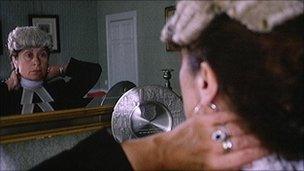What if all workplaces had to be a third female?
- Published

As a report suggests progress on closing the gender pay gap is slowing, lawyer and life peer Baroness Kennedy looks to the new shadow cabinet, where a third of members have to be female, and argues it could be an interesting blueprint for all workplaces.
So women will make up nearly half of Ed Miliband's shadow cabinet. I told my sons this was to foreshadow things to come.
The White House has just produced a report that says no quantum leap will be made on the issue of gender unless there is a critical mass of women in any workplace.
If we want things to change we are going to have to get tough - at least a third of the army to be women, a third of submariners and a third of the Arsenal football team.
It was the Arsenal bit that brought a narrowing of their eyes. I held their gaze with a fixed stare. This was a crucial test of the feminist mothering of sons.
"Could work. We haven't won the trophy for five years. There are no English players. But they'd have to be fit."
"Of course, they'd be fit." I said. "This is Premier League football we are talking about. Women can do it."

Would an influx of female players into Arsenal's men's first team boost women's status at work?
"Fit, Mum. Good looking. Distract the other side, Mum. It could work."
Men can laugh. But underneath the badinage is a continuing truth that, despite all the gains, women are still not up there in the top jobs; one woman in the Supreme Court, a tiny number heading FTSE companies, a third of all boards totally male, four women in a government cabinet of 23 (although Gordon Brown's first Cabinet was little better on this front - with just five women and 17 men).
It is not a great story. Last week Chambers Directory gave awards to lawyers and barely a woman got a mention. There were yards of men in penguin suits and hardly a sequinned frock to be seen.
When I became President of the Women of the Year Lunch the grumblers all asked why such an event was necessary in 2010.
"What are you thinking about, Helena. All that is old hat." Really?
And the naysayers are not all men on this score. Some women too think the day has gone for celebrating women's achievements, though they are usually women who live and work in the comfort zones.
I have worked too long in law to think that everything has been done on equality for women.
The prevalence of domestic violence and the failure of the justice system on rape cases are testament to continuing problems here, but the fact that women continue to suffer most human rights abuses around the world - from honour killing to genital mutilation, from stoning to forced marriage, from abortion of the girl child to sexual violence and trafficking - tells us that there is still much to done.
When I was a young woman at the Bar, there were chambers with an unofficial policy that they just did not take women - women did not have what it took to stand up in court and argue coherently or cross-examine. Our brains were not suited to the kind of logical discipline that the law required.

As a young barrister, Helena Kennedy observed sexism within the profession
Then there were those chambers that were cannier, whose leaders said: "Women? We are not against women. We've got one." Those were the days.
Women are now half the intake in most university courses, including law. They appear to be everywhere.
Yet women still do not follow through into the senior jobs. We keep being told it is just a matter of time and that evolution will solve the problem, as though, like fish growing feet, women will eventually develop into the kind of person who can wield power.
In most institutions, women have reached a plateau at around 18% in senior roles from the financial sector to the judiciary.
The interesting question now is why we are stuck. Usually it is a combination of factors around the inability of institutions to adapt and become more flexible to accommodate women's lives but it is also about the culture of organisations, exclusive networks which work to the disadvantage of women, and the failure of leading men to bring talented women on.
I always remember a woman friend, who was a Conservative politician, very astutely noticing that men did not "talk up" young women in the way they did young men.
It is partly that we tend to choose as our protegees people in whom we see our younger selves. There is a self-perpetuating tendency in all institutions for this reason which leads to their replication in the old order.
I had the good fortune of being mentored by some wonderful men who gave me opportunities and advice throughout my career but not all women have such good luck. The challenge is for men to break the old patterns in a conscious way.
The Women of the Year Lunch is an opportunity to celebrate women. Some have high profile but most do great things below the radar.
They have broken barriers and broken records, struggled against the odds and survived, created projects to improve our world and left us breathless with wonder.
What's to sneer at? Measuring achievement is a way of taking stock, paying tribute and sending out signals to all women that women are continuing to move on.
We have to keep doing that - out and proud of the contribution women make. And there is nothing po-faced about this event. Boy, do we laugh. But without the boys.
- Published11 October 2010